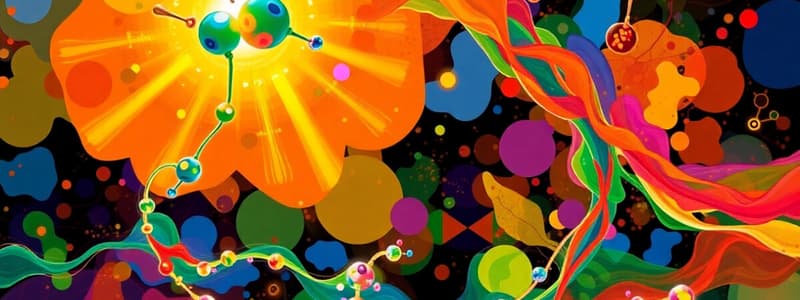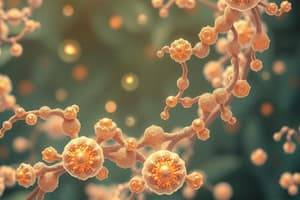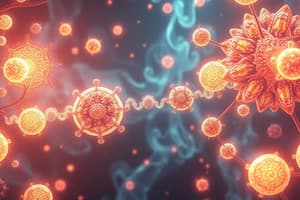Podcast
Questions and Answers
What is the main function of carbohydrates in living organisms?
What is the main function of carbohydrates in living organisms?
- Hormonal regulation
- Structural support in cells
- Genetic information storage
- Energy storage and supply (correct)
Which of the following best describes the energy available for the next trophic level if a secondary consumer has 100 units of energy?
Which of the following best describes the energy available for the next trophic level if a secondary consumer has 100 units of energy?
- 10 units (correct)
- 50 units
- 1 unit
- 1000 units
How does carbon typically move from the atmosphere to living organisms?
How does carbon typically move from the atmosphere to living organisms?
- Through photosynthesis (correct)
- Through decomposition
- Through combustion
- Through respiration
What would be an example of an autotroph?
What would be an example of an autotroph?
Which of the following processes takes carbon dioxide out of the atmosphere?
Which of the following processes takes carbon dioxide out of the atmosphere?
Which statement correctly describes the size comparison between cells and biomolecules?
Which statement correctly describes the size comparison between cells and biomolecules?
What happens to energy during photosynthesis?
What happens to energy during photosynthesis?
Which abiotic process moves carbon from the lithosphere to the atmosphere?
Which abiotic process moves carbon from the lithosphere to the atmosphere?
Which type of molecules typically end in -ose?
Which type of molecules typically end in -ose?
What are the products formed in the cellular respiration equation C6H12O6 + 6O2 → 6H2O + 6CO2?
What are the products formed in the cellular respiration equation C6H12O6 + 6O2 → 6H2O + 6CO2?
How many carbon atoms are found on the product side of the cellular respiration equation?
How many carbon atoms are found on the product side of the cellular respiration equation?
What is the universal energy currency for all cells?
What is the universal energy currency for all cells?
What term describes the energy required to initiate a chemical reaction?
What term describes the energy required to initiate a chemical reaction?
Which processes create a cycle involving the products of one serving as the reactants of the other?
Which processes create a cycle involving the products of one serving as the reactants of the other?
What might denature a protein?
What might denature a protein?
What is the primary function of enzymes in biochemical reactions?
What is the primary function of enzymes in biochemical reactions?
How is plant mass primarily gained during its growth process?
How is plant mass primarily gained during its growth process?
In a trophic pyramid, why does the mass of organisms decrease as one moves up the levels?
In a trophic pyramid, why does the mass of organisms decrease as one moves up the levels?
What defines biodiversity in an ecosystem?
What defines biodiversity in an ecosystem?
Which of the following best explains why CO2 levels are higher in the fall and winter months?
Which of the following best explains why CO2 levels are higher in the fall and winter months?
What biotic process allows water to enter the atmosphere?
What biotic process allows water to enter the atmosphere?
How do symbiotic relationships affect ecosystems?
How do symbiotic relationships affect ecosystems?
What process releases nitrogen to the abiotic parts of the biosphere?
What process releases nitrogen to the abiotic parts of the biosphere?
What organelle allows plant cells to perform cellular respiration?
What organelle allows plant cells to perform cellular respiration?
What is the name of the process that uses sugar and oxygen to produce energy in cells?
What is the name of the process that uses sugar and oxygen to produce energy in cells?
What trophic level is represented by a black bear that eats a fish?
What trophic level is represented by a black bear that eats a fish?
Which statement is true regarding the point of photosynthesis?
Which statement is true regarding the point of photosynthesis?
Where in a food web is the most stored energy found?
Where in a food web is the most stored energy found?
Which cells in an animal would contain the most mitochondria?
Which cells in an animal would contain the most mitochondria?
Where does the energy in glucose originally come from?
Where does the energy in glucose originally come from?
Which type of bond is represented in the picture mentioned?
Which type of bond is represented in the picture mentioned?
Which cycle is directly related to the atom of life?
Which cycle is directly related to the atom of life?
Which two cycles are directly related to both cellular respiration and photosynthesis?
Which two cycles are directly related to both cellular respiration and photosynthesis?
Which of the following methods releases carbon into the atmosphere? (Select all that apply)
Which of the following methods releases carbon into the atmosphere? (Select all that apply)
What explains why energy decreases through the trophic levels in an ecosystem?
What explains why energy decreases through the trophic levels in an ecosystem?
Are decomposers required in all cycles of nutrient cycling?
Are decomposers required in all cycles of nutrient cycling?
Which of the following describes an example of biotic cycling of matter?
Which of the following describes an example of biotic cycling of matter?
Which example correctly illustrates a biotic factor interacting with an abiotic factor?
Which example correctly illustrates a biotic factor interacting with an abiotic factor?
Which statement best describes the difference between a hypothesis and a theory?
Which statement best describes the difference between a hypothesis and a theory?
Which of the following identifies a key characteristic of science?
Which of the following identifies a key characteristic of science?
Which scenario represents a density independent limiting factor?
Which scenario represents a density independent limiting factor?
What is the primary difference between K-type and r-type organisms?
What is the primary difference between K-type and r-type organisms?
How can a niche be defined in an ecosystem?
How can a niche be defined in an ecosystem?
In a food chain, which of the following represents a heterotroph?
In a food chain, which of the following represents a heterotroph?
Which of the following is an abiotic factor affecting an ecosystem?
Which of the following is an abiotic factor affecting an ecosystem?
Flashcards
Transpiration
Transpiration
The process by which water vapor is released from plants into the atmosphere.
Decomposition
Decomposition
Decomposition of organic matter by bacteria and fungi.
Mitochondria
Mitochondria
The powerhouse of the cell, where cellular respiration occurs.
Cellular Respiration
Cellular Respiration
Signup and view all the flashcards
Covalent bond
Covalent bond
Signup and view all the flashcards
What trophic level is the black bear?
What trophic level is the black bear?
Signup and view all the flashcards
What trophic level is the tuna?
What trophic level is the tuna?
Signup and view all the flashcards
What trophic level is the algae?
What trophic level is the algae?
Signup and view all the flashcards
What are lipids?
What are lipids?
Signup and view all the flashcards
What are carbohydrates?
What are carbohydrates?
Signup and view all the flashcards
What are proteins?
What are proteins?
Signup and view all the flashcards
What are nucleic acids?
What are nucleic acids?
Signup and view all the flashcards
What is the 10% rule?
What is the 10% rule?
Signup and view all the flashcards
Are cells bigger or smaller than biomolecules?
Are cells bigger or smaller than biomolecules?
Signup and view all the flashcards
What happens to matter during photosynthesis?
What happens to matter during photosynthesis?
Signup and view all the flashcards
What happens to energy during photosynthesis?
What happens to energy during photosynthesis?
Signup and view all the flashcards
What type of molecules end in –ose?
What type of molecules end in –ose?
Signup and view all the flashcards
What is the function of photosynthesis?
What is the function of photosynthesis?
Signup and view all the flashcards
What are products in a chemical reaction?
What are products in a chemical reaction?
Signup and view all the flashcards
What are reactants in a chemical reaction?
What are reactants in a chemical reaction?
Signup and view all the flashcards
What is activation energy?
What is activation energy?
Signup and view all the flashcards
What is an enzyme?
What is an enzyme?
Signup and view all the flashcards
What is cellular respiration?
What is cellular respiration?
Signup and view all the flashcards
What is ATP?
What is ATP?
Signup and view all the flashcards
Photosynthesis
Photosynthesis
Signup and view all the flashcards
Where does the energy in glucose come from?
Where does the energy in glucose come from?
Signup and view all the flashcards
What is an ion?
What is an ion?
Signup and view all the flashcards
What is an isotope?
What is an isotope?
Signup and view all the flashcards
How many protons, electrons and neutrons does N have?
How many protons, electrons and neutrons does N have?
Signup and view all the flashcards
How many protons, electrons and neutrons does Be have?
How many protons, electrons and neutrons does Be have?
Signup and view all the flashcards
What type of bond is represented in the picture?
What type of bond is represented in the picture?
Signup and view all the flashcards
Are Decomposers Required in ALL Cycling of Nutrients?
Are Decomposers Required in ALL Cycling of Nutrients?
Signup and view all the flashcards
What is photosynthesis?
What is photosynthesis?
Signup and view all the flashcards
What is a trophic pyramid?
What is a trophic pyramid?
Signup and view all the flashcards
What is biodiversity?
What is biodiversity?
Signup and view all the flashcards
What is an ecosystem?
What is an ecosystem?
Signup and view all the flashcards
Testable
Testable
Signup and view all the flashcards
Independent Variable
Independent Variable
Signup and view all the flashcards
Dependent Variable
Dependent Variable
Signup and view all the flashcards
Scientific Theory
Scientific Theory
Signup and view all the flashcards
Scientific Law
Scientific Law
Signup and view all the flashcards
Hypothesis
Hypothesis
Signup and view all the flashcards
Biotic Factors
Biotic Factors
Signup and view all the flashcards
Abiotic Factors
Abiotic Factors
Signup and view all the flashcards
Study Notes
Biomolecules
- Lipids have no monomer
- Carbohydrates monomer is 1=
- Protein monomer is 1=
- Nucleic acid monomer is 1=
Energy Flow
- Secondary consumer death leaves energy for decomposers
- Energy at a trophic level is 10% of the previous level (energy = X/10)
Photosynthesis and Cellular Respiration
- Matter is rearranged during photosynthesis
- Energy changes form during photosynthesis
- Autotrophs produce their own food
- Heterotrophs consume other organisms for food
Other
- Cells are bigger than biomolecules
- Matter required for sugar production comes from external sources
- Energy for sugar production comes from the sun
- Examples of autotrophs and heterotrophs are needed for further study
- Independent and dependent variables are critical for experimentation.
Studying That Suits You
Use AI to generate personalized quizzes and flashcards to suit your learning preferences.




